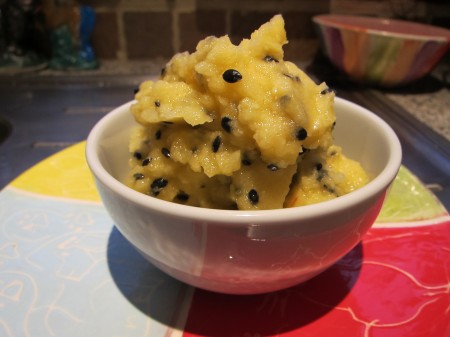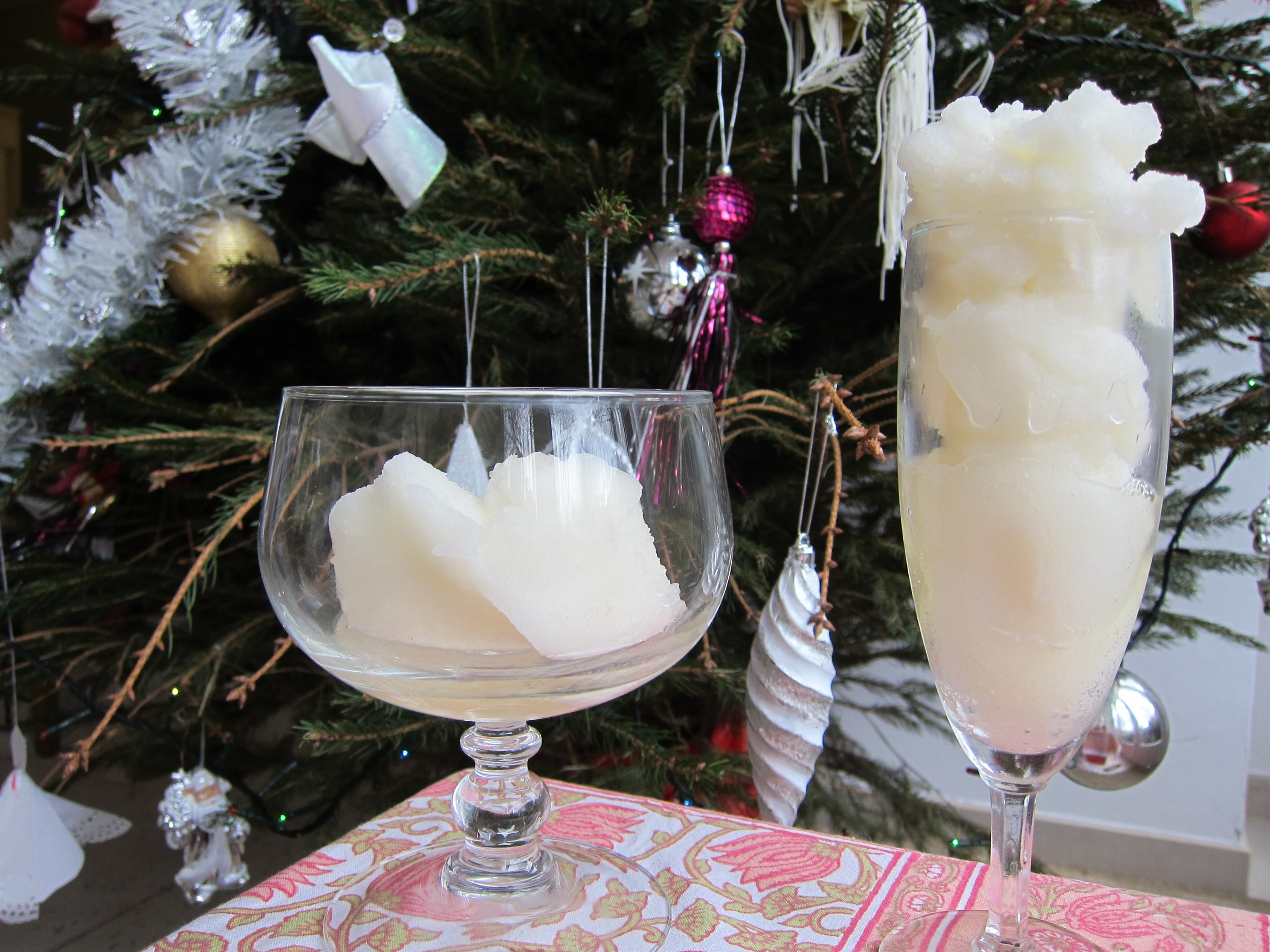Passion fruit sorbet
The word ‘passion’ stems from ancient Greek, and means ‘suffering’. And while the popular song tells us that “Love hurts”, the suffering that has given passion fruit its name is actually biblical. But even if you knew that, you probably do not know what the fruit symbolises in Japan …
Passion fruits grow on (certain species of) the Passion flower (Passiflora).
And the ‘passion’ to which the (Western) name refers is not of romantic, but of religious nature – it is the passion of Christ, i e the sufferings Jesus underwent prior to his crucifixion. Yes, that was new to me too!
Apparently, 16th century Spanish Catholic missionaries in South America, struck by the specific characteristics of the flower, saw in them symbolic reminders of the biblical passion.
But let’s not be too ethnocentric here – before the arrival of the Spanish, the South American indians may have connected the passion flower to sacred serpents and ancestral spirits. And in Japan, the flower is still known as the Clock face flower, and apparently also associated with homosexual young men (!). Clearly, the passion flower lends itself to a lot of fascinating symbolism – read more about it here!
And with regard to passions, most of us probably tend to think more about them in more romantic, hedonistic terms. The tasty passion fruits certainly serve as great inspiration also here: Elegantly sweet, with a certain complex tartness, and with edible seeds the fruits do not only taste good. They are also purported to bring about medical advantages like helping with high blood pressure, alleviating depression and even acting as a mild sedative.
Being widely used in everything from juices, drinks and desserts in the more tropical parts of the world where they are grown, passion fruits are slightly harder to come by elsewhere. Nevertheless, thanks to international trade and modern transportation techniques, they can usually be found also in the non-tropical parts of our world these days. The recipe I use is simple, and mainly a close adaptation of a recipe from Caroline and Robin Weir.
To seed or not to seed
Some people consider that the consistency of a good ice cream ought to be very smooth. While such silken frozen dessert certainly have their attraction, I myself tend to prefer not-so-smooth ones. In fact, I actually enjoy some substance, even in sorbets. The seeds of the passion fruit are edible, and make for a crunchy addition to the sorbet. They do not taste much on their own, so adding them is more a matter of aesthetics, crunchiness and healthy fibres than of flavour.
Should you, however, prefer a smooth, seed-less version, just pass the passion fruit purée through a sieve before churning!
Blending the sorbet base
Passion fruit purée on its own is not overly sweet, and its flavour all on its own could tend to be a bit overpowering. Therefore, I added some trusty simple sugar syrup (50 % sugar, 50 % water) to the base, together with some lemon (lime also works well) juice to counter a too sweet end result. As you can see from the picture above, the blend passed the Egg test, meaning that the sugar concentration should be fine for sorbets.
An egg white for added consistency
In order to improve the consistency and scoopability of this sorbet, I added a loosely whipped egg white to the base during churning. If you are worried about eating raw egg whites, the egg white can be omitted. But the sorbet is then likely to freeze harder in the freezer and gain a more compact consistency. If so, it may be best to try to enjoy the sorbet quite soon after having churned it (or add some softening inverted sugar to the sorbet base, like Agave nectar or corn syrup, or a small amount of alcohol).
The final result
The core passion fruit flavour really shines in this delightfully refreshing – and crunchy – sorbet. And in case you do not like to chew the passion fruit seeds, just remove them and go for ‘smooth’.
Or remove some seeds, in case all of them just seem to be too many for your taste. Or replace the seeds with some chopped up chocolate! Or why not hold on to the fibres and have it both ways ? Keep the seeds and add some chocolate too!
- Simple sugar syrup (125 ml water + 125 ml sugar)
- 250 ml passion fruit purée (approx. pulps and seeds of 12 passion fruits)
- Juice of 1 lemon or lime, depending on your citrus preferences
- (optionally) About 50 gram chocolate, chopped (of dark or milk-type)
- Prepare a simple sugar syrup by mixing 125 ml water with 125 ml sugar. Heat (or simply shake) the mixture until all the sugar has dissolved. Set aside to chill.
- Cut the passion fruits in halves, remove the pulp and seeds and put in a blender or equivalent. Blend to a purée, also adding the lemon/lime juice.
- If you do not like crunchy seeds, pass the purée through a sieve.
- Combine the syrup with the fruit purée, blend and let chill.
- Then churn in the ice cream maker according to instructions.
- Optionally, if you would like to add pieces of chocolate, do so towards the very end of the churning.
- Put in freezer-safe container, cover with plastic film and lid and store in the freezer.












For passion fruit sorbet , I rince the seeds in water and sugar to prepare the syrup and let the seeds dry before roasting them so they can be sprinkled on the sorbet. Delicious, crunchy and decorative at the same time.